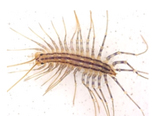
Problems with Centipedes are entirely controllable under professional care. Our treatment goal is to stop a problem at its source so it doesn’t keep coming back. Using state-of-the art equipment and methods, our licensed exterminators will inspect your home’s environment and construction to identify the problem and determine the best course of action. Contact us today!
Centipedes move swiftly toward darkened hiding places and they are normally are found in soil and leaf litter, under stones and deadwood, inside logs, and other similar places. They usually have a bland coloring with combining shades of brown and red. Subterranean species may lack pigmentation and many tropical species have bright colors.
They can be found in a wide variety of environments all over the world and sizes can range from a few millimeters in the smaller species to about 30 cm or 12 inches in larger species. There are estimated to be 8,000 species of centipede, however only about 3000 have so far been scientifically described.
Technically centipedes are arthropods belonging to the class Chilopoda of the subphylum Myriapoda. They are elongated animals that are divided into many similar segments and have 1 pair of legs per segment. Despite its name (meaning a hundred – legs), they can have a varying number of legs from under 20 to over 300. Centipedes have an odd number of pairs of legs.
They reproduce without contact with the opposite sex. The male will deposit a spermatophore for the female to take up. In certain types of centipedes, this spermatophore is deposited in a web, and the male undertakes a courtship dance to encourage the female to engulf his sperm. In other cases, the males just leave them for the females to find. In temperate areas eggs are laid in spring and summer.
Centipedes are predators, and mainly use their antennae to seek out their prey. They have a poisonous bite and their sting will hurt like a wasp or bee sting and some people may have an extreme allergic reaction to their venom. The digestive tract forms a simple tube, with digestive glands attached to the mouthparts. Like insects, centipedes breathe through a tracheal system, typically with a single opening, or spiracle on each body segment.
Centipedes require moist habitats. If they are plentiful, there may be an underlying moisture problem that should be corrected. The best way to keep them out of our home is by preventing entry and sealing cracks or holes. Look around the house for access points under doors and around basement windows and in the foundation. Seal cracks in cement which allows water to gather. If you have a lot of access points through the siding of the home, you should consider using caulks and foam sealants to plug all small cracks, crevices and gaps through which centipedes enter. These entry points should be reduced as much as possible.
Under certain conditions nearby centipede nests harboring hundreds, can migrate in the same direction towards a home. This will lead to infestations in the home if left untreated. Look to see where they are invading. In most cases, you will find them along one side or wall of your home. Look around this side of the property. Inspect nearby mulch, compost piles, wood piles, large rocks, sheds, cracks in cement walkways or driveways and stoops. Any of these locations can breed, feed and shelter these pests.
Once you know where they are coming from, you will be able to treat the area precisely and even remove excessive plant material. Clean up leaves. Replace old mulch that is decomposed. Move log piles away from the home. Rake thatch buildup from your lawn. By reducing these conditions, you take away food and harborage these pests need for survival.